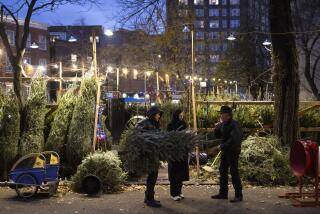Mom and Apple Pie : Orchards Luring City Folks With Hayrides, Ice Cream and Cider
SPRINGFIELD, Mass. — Apple growers in the Northeast are enjoying a bountiful harvest as a cool, rainy summer has turned into a crisp, clear fall.
“Now it’s our turn,” says David Lynch, president of the Massachusetts Fruit Growers Assn. He says the good crop comes none too soon for the region’s growers, who have weathered hurricanes, hail, burning heat and chemical scares over the last three years.
While the warm spring and cool, rainy summer kept tomatoes from turning red, delayed the sweet corn and led summer vacationers to despair, the apple trees found the weather near perfect, Lynch said.
And in New York and New England, apple picking makes for a fine family outing on an autumn afternoon.
Unlike most other apple growing areas, 60% of the 2 million bushels of apples grown in Massachusetts are sold retail at the orchard, according to state agriculture officials. Despite a small but growing export industry, most of the remainder end up on the shelves of regional stores and supermarkets.
And Massachusetts growers have helped eliminate the middleman by installing hayrides, doughnut and cider counters, ice cream stands and other attractions to lure city folks to their farm stands and pick-your-own orchards.
“It has pretty much come to the point where you have to have doughnuts and caramel apples and pie,” said Lynch, who runs a pick-your-own orchard in Stow. “What people are really looking for is not a food bargain but a way to kill a Sunday afternoon. But it is also a good deal for the farmer.”
Apple production is expected to be up at least 10% in most of the New England states except for Vermont, which wasn’t hit as hard by last year’s drought, and should see about the same harvest, said Bob Needom of the New England Agriculture Statistics Service.
“We are expecting our largest crops of Macs in four to five years,” said Rick Chandler of the Westfield-based New York-New England Apple Institute.
Despite inroads by Cortlands, Empires, Macouns, Romes and Red Delicious, the delicate McIntosh remains the premier apple in the region, he said. New York and Massachusetts produce about 14 million of the 20 million bushels of Macs grown in the United States.
Despite the good supply so far, both retail and wholesale prices have held at last year’s levels, the growers say.
“Of course anytime you have a large supply it’s going to have an affect on price,” Chandler said. “Last year was great for the European export market, but we don’t expect it to be as strong this year because the French also have an excellent crop.”
“The state of Washington pioneered the export market and it still dominates it,” he said, “but we’ve been able to create some niche markets for our Red Delicious, based on the flavor difference. The American consumer still buys primarily with the eye, but overseas they are more willing to try.”
But the slumping New England economy has brought some new faces into the apple orchards this fall, according to Lynn Frazer of the Massachusetts Department of Employment and Training.
Although most big growers still rely on Jamaican pickers, the number of local residents working in the orchards is up about 20% this fall, she said and “some companies tried to exclusively hire local workers.”
The average wage for pickers this season was about $6 an hour, she said.
More to Read
Sign up for The Wild
We’ll help you find the best places to hike, bike and run, as well as the perfect silent spots for meditation and yoga.
You may occasionally receive promotional content from the Los Angeles Times.






